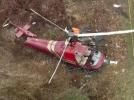Condor B753 near Las Palmas on Mar 22nd 2013, odour on board causes 2 flight attendants to pass out
A Condor Boeing 757-300, registration D-ABOC performing flight DE-5944 from Hamburg (Germany) to Las Palmas,CI (Spain) with 242 passengers and 8 crew, was descending towards Las Palmas when an odour on board caused three flights attendants to feel unwell, the first officer donned his oxygen masks. The aircraft continued for a safe landing.
The airline confirmed the odour on board and reported that three flight attendants felt unwell, the first officer donned his oxygen masks on approach to Las Palmas' Gran Canaria Airport. The other crew members and passengers did not report feeling unwell. After landing the crew activated the APU to determine the cause of the odour, following the activation the odour re-intensified causing two flight attendants to become temporarily unconscious. The flight attendants and first officer were taken to a hospital in Las Palmas, released, and are on the way home. The aircraft had undergone a C-Check in March 2013. Spanish and German Authorities are investigating.
The German BFU confirmed they were informed about the event as described, Spain's CIAIAC is investigating the occurrence with the assistance of the BFU.
Passengers described a strong odour of oil fumes throughout the flight, they felt unwell with head aches and dizziness.
The return flight DE-5945 was postponed to the next day, a replacement Boeing 767-300 registration D-ABUC was dispatched to Las Palmas and reached Hamburg with a delay of 19 hours.
The occurrence aircraft resumed service on Mar 26th 2013.
On Apr 17th 2013 the Spanish CIAIAC reported that the aircraft had undergone de-icing before departure from Hamburg. Departure and cruise had been uneventful, during the approach at about 6000 feet the flight crew noticed a strong smell in the cockpit that seemed to originate from the air conditioning outlets. Immediately after the purser called the cockpit reporting that the strong smell was perceived in the cabin, too. About 2 minutes later the first officer indicated he felt unwell with dizziness, the captain recommended to use the oxygen mask, the first officer donned his oxygen mask and felt immediate improvement. The landing was continued without further incident, the first officer removed the oxygen mask during taxi. After the passengers had disembarked, preparations for the return flight began, company dispatch instructed to have the engines checked for bird ingestion and verify hydraulic and oil quantity levels, check the waste water lines and the air conditioning particle filters, no anomalies were identified in these tests. An engine run near the threshold of runway 03L was coordinates with tower, the aircraft was towed to the runway, only the APU was running at that time, on board was flight and cabin crew as well as a maintenance technician and a company operator. Near the threshold the crew connected the APU bleed with the left hand air conditioning system, which right away resulted in a strong smell, two cabin crew suffered from physical problems. The air conditioning system and APU bleed air was disconnected, all aircraft doors opened to ventilate the aircraft, oxygen was provided to the two flight attendants and paramedics called in who took the flight attendants to the hospital, where they stayed over night. 2 CIAIAC inspectors were dispatched to Las Palmas who together with company technicians examined the aircraft however without finding any anomaly. An aerotracer device found traces of glycol and Pattex (adhesive) in the cabin air. Another repeat of the tests performed by the crew near the runway threshold did not produce any smells, all tests remained negative. The only finding remained about 5 liters of glycol spilled in the APU compartment, remnants of the de-icing in Hamburg, which were removed before the aircraft returned to service.
On Mar 18th 2014 the CIAIAC released an interim statement stating: "In April 2013 the health of one of the flight attendants who had been onboard during the flight of 22 March 2013 worsened, requiring hospitalization. The symptoms presented were overall muscle fatigue, in particular proximal of the lower limbs, difficulty walking, sensory disorder, trouble concentrating and general fatigue. She was released from the hospital and continued treatment on an out-patient basis. The symptoms persisted and her health did not show improvement, even worsening at times to the point where she had to be hospitalized. As of the date of this interim report, she still has not been able to return to work. Although the tests performed on her have not been able to identify the cause of the symptoms afflicting her, the medical report from the hospital indicated poisoning caused by some type of neurotoxin."
The CIAIAC reported that airline technicians in the presence of two CIAIAC inspectors exhaustively examined the aircraft at Las Palmas but did not find any anomaly. The tests were repeated with crew on board again with no findings, the crew did not smell anything and suffered no physical alteration, the aerotracers used during that test did not register anything abnormal. Another test with all combinations of possible configurations of air conditioning systems also did not detect any anomaly. The engines, air conditioning ducts, hydraulic lines, APU etc. were checked, the only noticeable finding was about 5 liters of glycol spilled into the APU compartment. The glycol was removed.
On Mar 26th 2013 the aircraft was ferried to Frankfurt, all test equipment and the technicians were on board that flight, the aerotracer was operational throughout the flight.
About 100 minutes into the flight the aircraft encountered light turbulence during which intense smell filled the cabin prompting the flight crew to don their oxygen masks. Nonetheless, the first officer as well as the purser felt their tongues going numb and their throat being irritated. The turbulence stopped after about 10 minutes and the smell dissipated. The crew removed the oxygen masks, the irritations and numbness ceased.
While descending towards Frankfurt the odour returned, the pilots again donned their oxygen masks. The purser felt her fingers going numb. The smell and symptoms ceased when the aircraft descended through 6000 feet.
The operator requested assistance by the aircraft manufacturer who deployed a specialist team to Frankfurt. Samples were taken during flights and analysed in laboratory without finding any anomaly.
The CIAIAC concluded the interim factual report: "A blood sample taken from the flight attendant was sent to a laboratory in the United States that specializes in neurotoxin poisoning, specifically in devising methods to identify the presence of damage to the nervous system that is usually caused by these substances. The analysis of the sample concluded that it exhibited characteristics consistent with damage to the nervous system."
The CIAIAC stated the next steps of the investigation will be:
- Continue monitoring the physical condition of the two FAs who have not been able to return to work so as to determine the cause of their ailments.
- Investigation into the analytical methods used to identify toxins.
- Investigation to determine the source of the odor.
- Joint identification and review of similar cases with the German accident investigation authority (BFU).
http://avherald.com/h?article=45fa1f5b














Komentarze